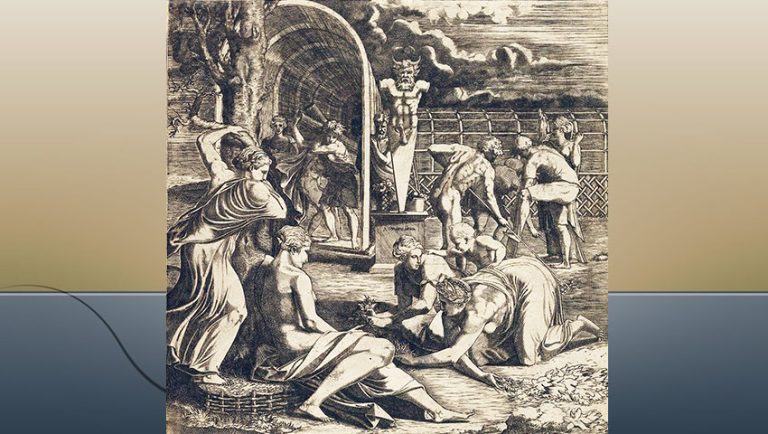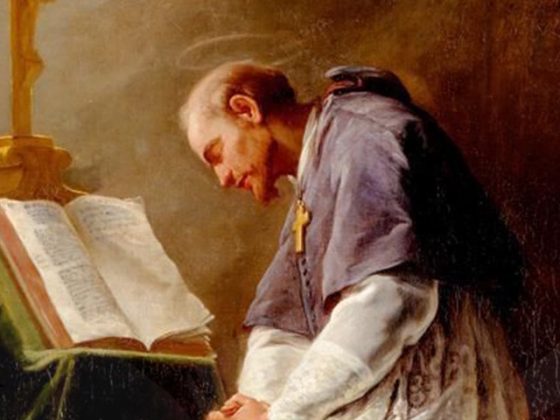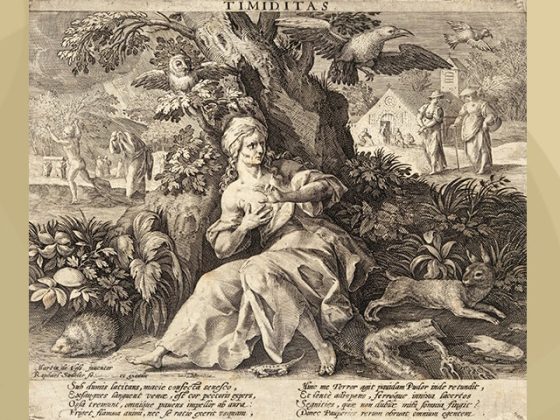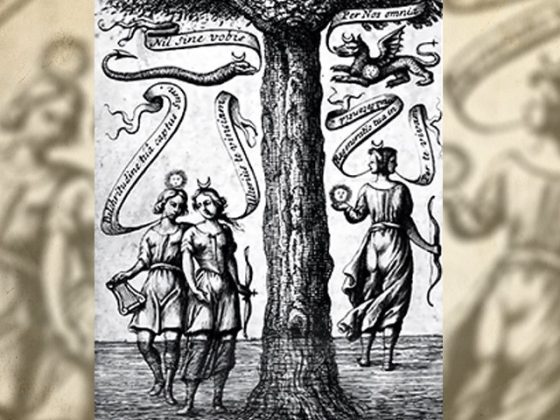My endearing readers:
It is with great pleasure that I send you the description of this engraving entitled…
…THE GARDEN OF THE GODDESS POMONA
First of all, we have to say that the present engraving entitled The Garden of Pomona was made by Léon Davent, a French engraver of the mid-sixteenth century. The original drawing of the engraving was made by Francesco Primaticcio (1504-1570), an Italian painter, architect and sculptor who spent most of his life in France. The two of them, Léon Davent and Francesco Primaticcio, were among the principal artists who worked on the royal palace of Fontainebleau, France, between 1531 and 1547.
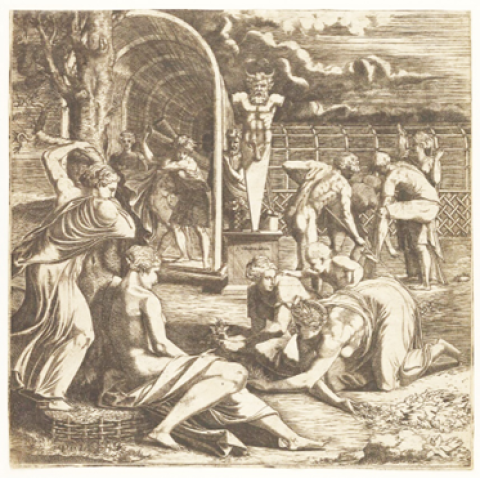
Léon Davent, mid-sixteenth century
This engraving is dedicated to Pomona and her garden, the Roman goddess of fruits. In most paintings, Pomona appears in the middle of a garden full of fruits accompanied by the god Vertumnus.
On the right side of the drawing we can see three figures working the land, three naked or semi-naked men guided by a woman. This woman is the representation of the Divine Mother ─Stella Maris─. She always carefully observes our alchemical works. The three men are the representation of the THREE PRIMARY FORCES OF CREATION.
On the rectangular pedestal, like an altar because it has offerings of fruits in baskets, it seems that it is written in French Fontaine d'eau –'the fountain of water'–.
On it we can see a sculpture representing Priapus, a god of fertility in Greek mythology. He was depicted as an ithyphallic god whose mission was to guard the vineyards and gardens, especially the orchards. The most interesting commentary found about this god is that, according to Diodorus, Greek historian and mythographer, 90 BC-30 BC, Priapus was related to the myth of Osiris. It would be the deification by Isis of the virility of Osiris.
On the right side of this altar or sculpture, at the back, a man appears. This man symbolizes the solar dynasties supervising the unfolding of the inner Great Work. Subsequently, in the foreground, two women can be seen accompanied by a child, kneeling in front of two other women leaning against a tree. These two kneeling women are parts of our REAL BEING, and one of them represents the virtue of HUMILITY, for which she wears a laurel wreath and in one of her hands she carries a huge bouquet of sacred herbs. The child who accompanies them symbolizes the nascent Christ. The X-shaped position of the arms of one of the women is noteworthy. This position reveals the incessant crossings of our Sulfur with our Mercury. The other two women leaning against a tree also represent parts of our own BEING. The BEING is the very Sephirotic Tree itself that supports its various sacred parts.
Next, we can see two other male figures accompanied by a female one coming out of a tunnel-like construction and carrying two columns on their shoulders. Those figures are the inner workers of our alchemical work, and the two columns they carry on their shoulders are the metaphysical channels that are found on each side of our spine —namely: IDA and PINGALA—. The woman who accompanies these two men is, once again, our blessed Mother Goddess Kundalini, who makes the transmutatory work advance.
Encyclopedias tell us that Pomona was, in Roman mythology, the goddess of fruit, and, by extension, of fruit trees, gardens and orchards; so she was also that of the olive tree and of the vine. The pruning knife or sickle were her attributes.
The name of the goddess clearly derives from pomum, ‘fruit', and she is therefore called Patrona pomorum, ‘Lady of fruits'. She had a sacred grove, the Pomonal, on the road from Rome to Ostia. A flamen took care of her cult. The flamen was a Roman priest regarded as the living statue of the God to whom they rendered their services. The person of the flamen was sacred and inviolable. They were the inheritance of an antiquity full of mysterious shadows. Their name, from the same Indo-European root as the Indian term Brahmin, referred to the breath ─flatus─ with which they lit the Sacred Fire of the altar. They were the most prestigious priests of ancient Rome, even on a par with the pontiffs.
The wife of a flamen was considered equally sacred, being the symbol of conjugal piety and chastity. She had to weave her husband's ceremonial garment, a purple woollen cloak.
During ceremonies they wore a mitre topped with an olive branch for him and a pomegranate branch over a pointed hairstyle –tutulus– for his wife. If, during a sacrifice, the priest's cap or mitre fell off, he was instantly expelled from the office he occupied.
Pomona's partner was the god Vertumnus, who, Gnostically, is none other than LUCIFER, and he personified the notion of change, of the mutation of vegetation during the course of the seasons. Vertumnus was credited with the gift of transforming himself into all the forms or things he desired, which is one of the attributes of the blessed Lucifer.
The most famous account of the myth of Vertumnus and Pomona is that of Ovid, Roman poet, 43 BC-17 AD, mentioned in his work The Metamorphoses. In this work by Ovid, Vertumnus is said to take the form of an old woman and urge the reluctant goddess to marry by showing her an elm entwined by a vine. Undoubtedly, in order for our alchemical garden to flourish, the masculine and feminine forces are needed, and hence such a proposition. For this reason, in painting and literature the elm entwined by a vine was used as a symbol of marriage, of a union for eternity. The old elm will never die, while always being nourished by the vine.
I am now attaching a beautiful painting that illustrates this myth, attributed to the Italian painter Giovanni Francesco Melzi (1493-1572), a pupil of Leonardo da Vinci. Note that in this painting you can see in the distance a rocky bridge on which, Gnostically speaking, we must hang our inner Judas. Likewise, near this bridge, to the right of the goddess Pomona, we are pointed out a stream that flows and allegorizes the Nirvanic Path, while to the right of the old woman ─Lucifer─ we can see a mountainous, rocky, arid area, which indicates the Dry Path alchemically speaking. Both figures, the goddess Pomona and the old woman ─Lucifer─, are seated at the foot of the elm tree, which is embraced by the vine, and some rocks serve as a seat for them.
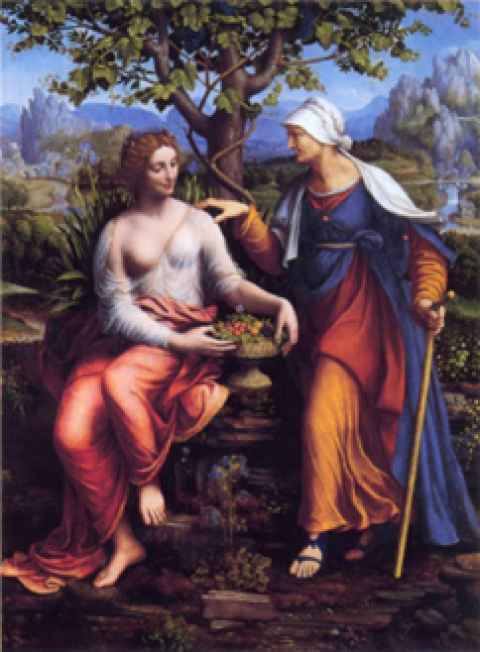
Giovanni Francesco Melzi (1493-1572)
Permitidme ahora regalaros unas frases para vuestra reflexión:
«El genio triunfa siempre, genio que se deja vencer no es nunca genio».
Benavente
«El talento es una magistratura, el genio es un sacerdocio».
Victor Hugo
«El genio es una revelación de Dios».
Calderón
«El genio se compone del dos por ciento de talento y del noventa y ocho por ciento de perseverante aplicación».
Beethoven
«Los genios son una dinastía. No hay otra. Ellos llevan todas las coronas, incluso la de espinas».
Victor Hugo
DE PROFUNDIS.
─‘From the depths’─.
KWEN KHAN KHU


